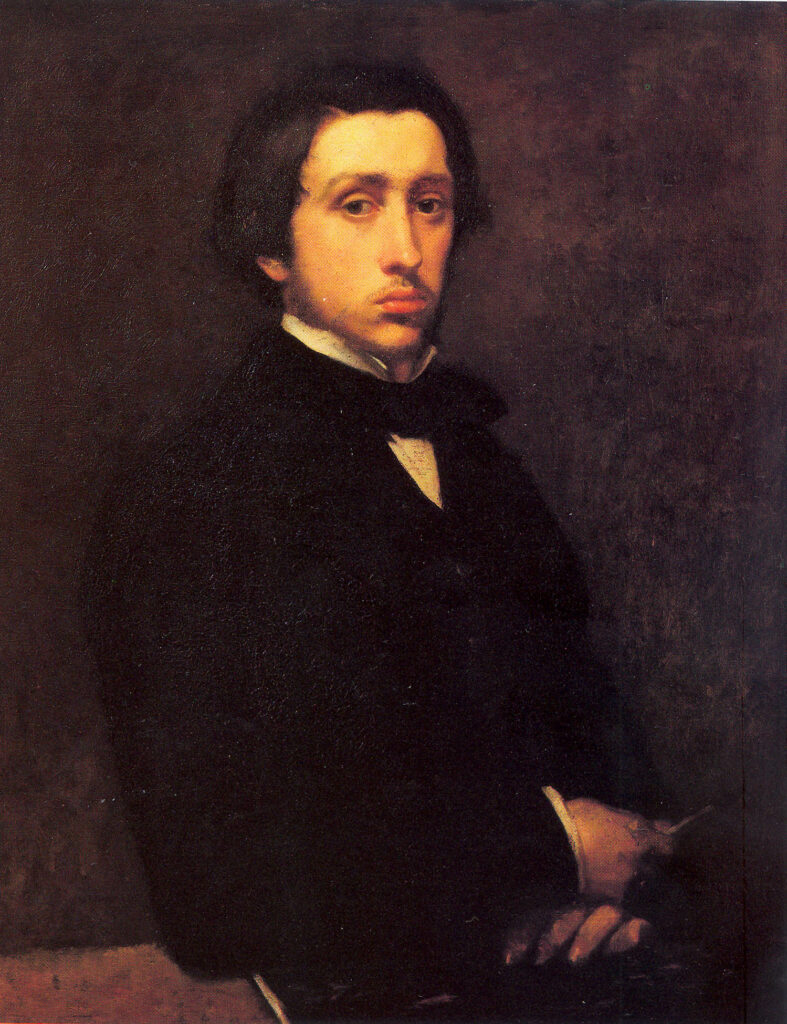

Introductory
Degas Edgar (1834-1917)
Degas Edgar (1834-1917), was born in Paris of a wealthy family. He studied at the Ecole des Beaux-Arts under a pupil of ingres, whom he knew and greatly admired. His early works – family portraits and some history pictures – suggest that he was to develop into an academic painter in the Ingres tradition. By the late 1860s, however, he had begun to develop a deceptively casual composition, probably influenced by Manet and possibly also by Whistler, and certainly by snapshot photography.
He knew Manet well, as he did Bazille, Berthe Morisot and Tissot, and was a frequent member of the circle which gathered round Manet, where he also met Fantin-Latour, Renoir, Constantin Guys, Cezanne, Monet, Sisley and Pissarro. During the Franco-Prussian War he remained in Paris and in 1872—3 he visited relations in New Orleans. There he painted only a few pictures, but these – and those executed after his return to Paris – show him using unusual viewpoints and purely contemporary subject matter, e.g. the Cotton Exchange in New Orleans. He ceased exhibiting at the Salon in 1870, and in 1874 he took part in the first Impressionist Exhibition, as he did in six of the subsequent seven.
His works could only be seen in public at these group exhibitions, always received with hostility and ridicule, or at the dealer, Durand-Ruel, whose patient and persevering faith in Impressionism nearly ruined him. Like Manet, Degas was a grand bourgeois with a private income, and he was less than understanding towards others in the group – e.g. Renoir – over their defections from the exhibitions which he largely organized, in order to send works to the Salon in an endeavour to attract purchasers.
His first pictures of dancers were painted about 1873, and from then on ballet girls, laundresses, models dressing and bathing, and cabaret singers became his principal subjects. He recorded the manners and movements of a society which he observed almost as if it were another world, treating the figures as the material of his investigations into light, colour and form, as much as the pastel or paint he used. Technically, he was one of the greatest experimenters and innovators.
His sound knowledge of the traditional technique of oil-painting enabled him to make endless trials of various media and mixtures such as oil paint thinned with turpentine after the oil has been partly extracted with blotting-paper (peinture a I’essence), pastel used in superimposed layers, or with watercolour or spirit-thinned oil paint, or thinned with water, gouache, egg-tempera, etching, drypoint, monotype, lithography, aquatint and drawing in every kind of material. In later life, he used pastel more than any other medium, and as his eyesight weakened his handling became broader and freer. There are also seventy-four pieces of sculpture – late works – including ballet dancers and figures in movement, originally executed in wax, but now generally cast in bronze. The most unusual is the large figure of the little ballet girl wearing a real tutu (London, Tate).
There are works in Baltimore (Walters), Berlin, Berwick on Tweed, Birmingham, Boston (Mus., Gardner), Cambridge Mass. (Fogg), Chicago, Cleveland Ohio, Columbus Ohio, Copenhagen, Detroit, Dumbarton Oaks, Edinburgh, Frankfurt (Stadel), Glasgow (Burrell), Hartford Conn., Leicester, Liverpool, London (NG, Tate, V&A and Courtauld Inst.), Los Angeles, Lyons, Malibu Cal. (Getty), Minneapolis, Moscow, New York (Met. Mus., M of M A, Brooklyn and Frick Coll.), Northampton Mass., Ottawa, Paris (Mus. d’Orsay and Mus. Moreau), Pau, Philadelphia (Mus.), Rochester NY, Sao Paulo, St Louis, Stockholm, Toledo Ohio, Toronto, Vienna, Walsall, Washington and elsewhere. London (Tate) and New York (Met. Mus.) have good collections of the sculptures. de heem see heem.
Source : Murray, Peter and Linda: Dictionary of Art and artists. England, Penguin, 1991